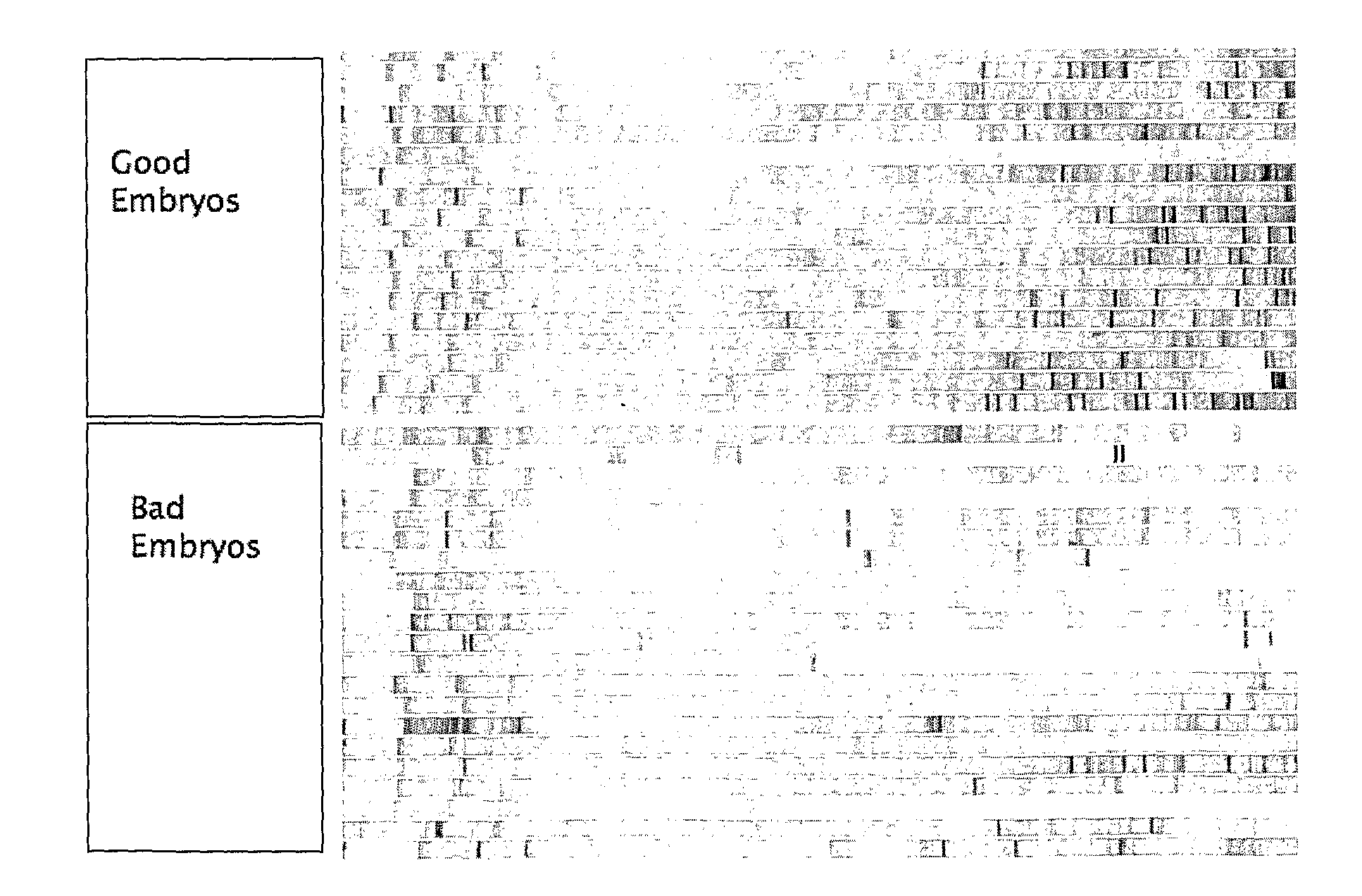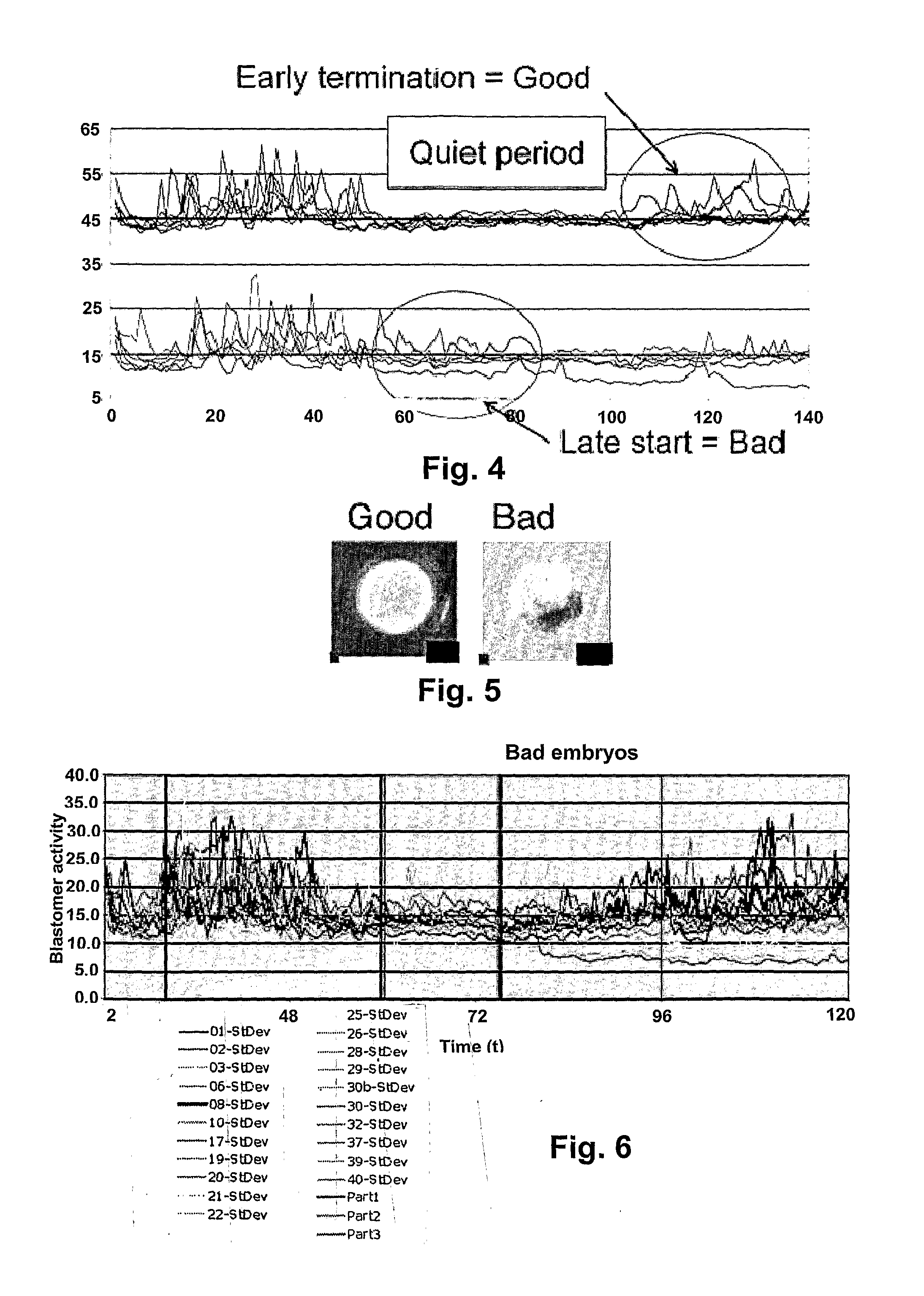Embryo quality assessment based on blastomere division and movement
a technology of blastomere division and quality assessment, applied in the field of embryonic quality assessment based on blastomere division and movement, can solve the problems of affecting the quality of embryonic cells, time-consuming, etc., and achieves the effect of good quality and higher baseline values
- Summary
- Abstract
- Description
- Claims
- Application Information
AI Technical Summary
Benefits of technology
Problems solved by technology
Method used
Image
Examples
example 1
[0077]Materials and methods. Bovine immature cumulus-oocyte complexes (COCs) were aspirated from slaughterhouse-derived ovaries, selected and matured for 24 h in four-well dishes (Nunc, Roskilde, Denmark). Each well contained 400 μL of bicarbonate buffered TCM-199 medium (Gibco BRL, Paisley, UK) supplemented with 15% cattle serum (CS; Danish Veterinary Institute, Frederiksberg, Denmark), 10 IU / mL eCG and 5 IU / mL hCG (Suigonan Vet; Intervet Scandinavia, Skovlunde, Denmark). The embryos were matured under mineral oil at 38.5° C. in 5% CO2 in humidified air. Fertilization was performed in modified Tyrode's medium using frozen-thawed, Percoll-selected sperm.
[0078]After 22 h, cumulus cells were removed by vortexing and presumptive zygotes were transferred to 400 μL of culture medium, composed of synthetic oviduct fluid medium with aminoacids, citrate and inositol (SOFaaci) supplemented with antibiotics (Gentamycin sulfate, 10 mg / ml) and 5% CS and incubated at 38.5° C. in 5% CO2, 5% O2, 9...
example 2
[0088]Materials and methods. Same as for Example 1
Results
[0089]Initial protein synthesis in mammalian embryos use maternal mRNA from the oocyte, but after a few cell divisions the embryonic genome is activated, transcribed and translated. The switch from maternal genome to embryonic genome is a crucial step in embryo development. The period occurs at the 8-cell stage for bovines and has a relatively long duration for human embryos the switch occurs earlier at the 4 to 8 cell stage and has a shorter duration.
[0090]A quiet period of very little cellular movement is observed for most mammals when the embryonic genome is activated and protein synthesis switches from maternal to embryonal genes. If this period has: i) Early onset, ii) very low activity (=little cellular movement=quiet) and iii) early termination then it is a strong indication of a high quality embryo. The quiet period is often delayed, and sometimes interrupted by cellular movement in poor quality embryos. An example of ...
example 3
[0091]Materials and methods. Same as for Example 1
[0092]Results. In poor quality embryos that subsequently cease development particular and persistently immobile regions are often observed which persist and ultimately lead to developmental arrest. Such immobile regions may be associated with extensive fragmentation or blastomere death and lysis. If these regions are larger than a given percentage at a given developmental stage then the embryo has very low probability to survive. In high quality embryos the cellular motility that ensue briefly after each cytoplasmic division event is initially distributed over the entire embryo surface (i.e. all blastomeres move slightly), only after compaction in the morula stage is localized movement seen
[0093]Embryos that develop to blastocysts such as the left panel in FIG. 5 have uniformly distributed blastomere activity. Embryos that do not have uniformly distributed blastomere activity such as the right panel in FIG. 5 never develops into a bl...
PUM
| Property | Measurement | Unit |
|---|---|---|
| temperature | aaaaa | aaaaa |
| humidity | aaaaa | aaaaa |
| humidity | aaaaa | aaaaa |
Abstract
Description
Claims
Application Information
 Login to View More
Login to View More - R&D
- Intellectual Property
- Life Sciences
- Materials
- Tech Scout
- Unparalleled Data Quality
- Higher Quality Content
- 60% Fewer Hallucinations
Browse by: Latest US Patents, China's latest patents, Technical Efficacy Thesaurus, Application Domain, Technology Topic, Popular Technical Reports.
© 2025 PatSnap. All rights reserved.Legal|Privacy policy|Modern Slavery Act Transparency Statement|Sitemap|About US| Contact US: help@patsnap.com



